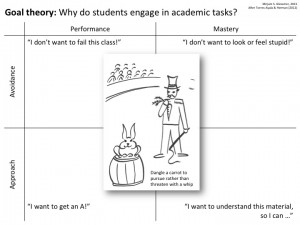
Motivation: dangle a carrot rather than threaten with a whip!
Why do students engage in academic tasks?
Next week I am giving a workshop on teaching large classes at TU Dresden. I gave a similar workshop there in spring, but because of its success I’ve been given twice as much time this time around. So there is a lot of exciting content that I can add to the (obviously already exciting!) workshop ;-)
When preparing what I want to talk about, I came across a paper that discusses motivation theories in the context of engineering education, and, even better, tailored to telling teaching assistants how they can improve their classes: “Motivating Learners: A Primer for Engineering Teaching Assistants” by Torres-Ayala and Herman, 2012. They give a great overview over theories on motivation, and today I want to talk about one of them:
Goal theory
Goal theory describes the different reasons why students engage in academic tasks. There are two different kinds of drivers students can have, avoidance or approach, and two kinds of quality of learning they can be striving for: performance and mastery.
Students who are in a state of avoidance and look for performance will state something like “I don’t want to fail this class!”, whereas students in avoidance striving for mastery will say “I don’t want to look or feel stupid!”. Students with an “approach” attitude, on the other hand, will say “I want to get an A!” if they are aiming at performance, or “I want to understand this material, so I can do … with it”.
While all four kinds of motivation for learning will produce some kind of learning, students with an approach mindset striving for mastery will be the most intrinsically motivated students who will likely do best.
So what does this mean for your teaching? Making students learn to avoid repercussions or public shaming, hence driving them into an avoidance mindset, is not as effective as creating a learning environment where students work towards something positive. And while having students work to earn, for example, bonus points gets them going in the short run, in the long run it is much more effective to help them discover what they can use the skills and knowledge for in their own lives for, discover the intrinsic value in them, and strive to learn because they want to apply the knowledge and skills to better their own future.
Or, as the authors say: Dangle a carrot to pursue rather than threatening with a whip.
—
Ana T. Torres-Ayala, & Geoffrey L. Herman (2012). Motivating Learners: A Primer for Engineering Teaching Assistants. American Society for Engineering Education

How your students might be hurting themselves by skipping classes | says:
[…] Third, if we want mandatory attendance, policies that punish for missing class are more successful than those rewarding attendance (in most studies – not all). This seems to contradict the classical “dangle a carrot rather than threaten with a whip“. […]
And even more on motivation | says:
[…] week we talked about motivation quite a bit: First about why do students engage in academic tasks?, then about how motivation is proportional to the expectation of achieving a goal. Today I want to […]